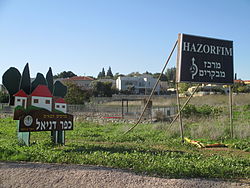Kfar Daniel
Kfar Daniel
כְּפַר דָּנִיֵּאל | |
|---|---|
 | |
| Coordinates: 31°55′59″N 34°56′2″E / 31.93306°N 34.93389°E | |
| Country | Israel |
| District | Central |
| Council | Hevel Modi'in |
| Affiliation | Kibbutz Movement |
| Founded | 9 October 1949 |
| Founded by | Mahalniks |
| Population (2022)[1] | 678 |
Kfar Daniel (Hebrew: כְּפַר דָּנִיֵּאל, lit. 'Daniel Village') is a moshav shitufi in central Israel. Located around four kilometres south-east of Lod and covering 2,900 dunams, it falls under the jurisdiction of Hevel Modi'in Regional Council. In 2022 it had a population of 678.[1]
History[edit]
During the Ottoman period, the area belonged to the Nahiyeh (sub-district) of Lod that encompassed the area of the present-day city of Modi'in-Maccabim-Re'ut in the south to the present-day city of El'ad in the north, and from the foothills in the east, through the Lod Valley to the outskirts of Jaffa in the west. This area was home to thousands of inhabitants in about 20 villages, who had at their disposal tens of thousands of hectares of prime agricultural land.[2]
The village was established on 9 October 1949 by Mahalniks (overseas volunteers in the War of Independence) from English-speaking countries on the lands of the depopulated Palestinian village of Daniyal.[3][4] It was initially called Irgun Beit Hever after the organisation which the founders were members of, but was later renamed in honour of Daniel Frish, a president of the Zionist Organization of America who died in the year the village was established, with the new name resembling that of the former Arab village.[5]
The nearby Daniel Interchange connecting Highway 1 and Highway 6 is named after the village.
References[edit]
- ^ a b "Regional Statistics". Israel Central Bureau of Statistics. Retrieved 21 March 2024.
- ^ Marom, Roy (2022). "Lydda Sub-District: Lydda and its countryside during the Ottoman period". Diospolis - City of God: Journal of the History, Archaeology and Heritage of Lod. 8: 103–136.
- ^ Khalidi, Walid (1992). All That Remains: The Palestinian Villages Occupied and Depopulated by Israel in 1948. Washington D.C.: Institute for Palestine Studies. p. 374. ISBN 0-88728-224-5.
- ^ Morris, Benny (2004). The Birth of the Palestinian Refugee Problem Revisited. Cambridge: Cambridge University Press. p. xxi settlement #73. ISBN 978-0-521-00967-6.
- ^ How we learned to forget the villages we destroyed 972 Mag, 16 October 2016

